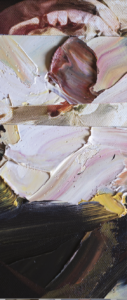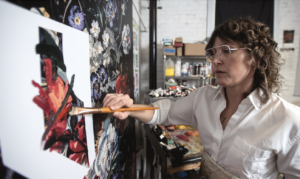pAInt: UofL professor explores blurred lines between art and technology
Originally posted June 21, 2024 in UofL News
They say seeing is believing. But when most of what we see is filtered through screens and algorithms, it’s hard to be sure. Is that selfie touched up? And was that viral video real or made with artificial intelligence?
The impact of technology on how we experience the world creates both new possibilities and a host of practical and ethical questions. But Tiffany Calvert, an associate professor in UofL’s Hite Institute of Art + Design, is looking for answers — and to find them, she’s going straight to the source.
In her “Machine Vision Series,” Calvert partners with her own virtual apprentice, a bot trained to paint as her collaborator. Calvert believes working with AI can help us understand its implications and explore the blurring line between what we see and what’s real.
“I often get asked, ‘is AI your collaborator or your antagonist?’ ” said Calvert, one of many at UofL exploring the world through creativity. “The answer is that it’s complicated. I’m working with AI in a way that both criticizes its vulnerabilities and has a healthy appreciation of what it can do.”
ART DOTCOM
Cutting her artistic teeth at the height of the ‘90s Dotcom bubble, Calvert has long been fascinated with the intersection of art and technology. Then, traditional forms of visual expression were converging with new digital tools for photo-editing and design.
“There was something exciting about that convergence and the fact that I could use these tools to build something creative,” she said. In a way, Calvert saw technology as a medium similar to charcoals or paint. But as technology has advanced, now capable of its own analysis and decision-making, it’s become more of an artistic partner.
For her “Machine Vision Series,” Calvert trained her AI collaborator by feeding it more than 1,000 historical still life paintings of tulips in bloom. It’s a technique known as machine learning, where a computer is shown examples to learn what something looks like — be it cars, crosswalks or frescos.
After a while, the AI could recognize the tulips and begin to ‘paint’ its own. Calvert would paint, then the computer, then Calvert again, caking on thick, colorful globs of oil pigment to differentiate herself from the machine.
The partnership might seem counterintuitive. Art, after all, is built on humanity and meaningful imperfection, but you’d expect a computer algorithm — something literally built on logic — to produce only the predictable and perfect.
But when the AI painted, it wasn’t perfect. The algorithm can only interpret based on what it’s seen before, and sometimes, it misinterpreted or made logical leaps. Some AI-generated tulips were distorted in interesting and unpredictable ways like confusing the bulb of a flower with, say, an oyster or halved peach.
“Those distortions behave like a mutating virus,” Calvert said. “It’s interesting, because while it’s incredible that the technology can generate beautiful imagery, those misinterpretations reveal the underlying humanity in the code, and the biases inherent in datasets.”
THE HUMANITY
While flowers that look like peaches might seem like a problem, for Calvert, it’s a good thing. Artists are much more interested problems than answers.
“That’s where the interesting stuff happens,” she said. “These problems allow me to explore larger issues. How is this a metaphor for technology infecting our world and what precedents are out there?”
AI can be a powerful tool, she said, but it’s only as good as its human creators and users — who aren’t always clear, make mistakes and sometimes behave irresponsibly, irrationally or maliciously.
“The technology is obviously only as good as the information we give it, how we program it and how we use it,” she said. “That’s the underlying paradox, the humanity in the machine.”
Take the technology that created the tulips in Calvert’s paintings. Those specific tulips are the result of creative farming — a plant virus that boomed during the 17th century Dutch Golden Age, creating an explosion of new and unique tulip colors and variants.
That virus underpinned Tulip Mania, the first speculative bubble of the modern era, where the flowers were as much an investment and status symbol as decoration. Dutch consumers might have purchased a tulip bulb for more than the average salary.
“When Tulip Mania happened, the technology got way out of control from both an economic perspective and a biological one, where it’s now a problem for farmers,” Calvert said. “So humans, in their hubris, didn’t understand the destruction they’ve created.”
That’s why, Calvert said, it’s important to take a critical eye to technology and understand its implications. For example, with AI technology readily available and the content it creates surging across the internet, a recent Forbes survey shows some 75% of consumers worry AI will be used for misinformation.
“It’s interesting to explore, because AI is both really critical to solving important problems and at the same time, it depends on who programs and uses it,” she said. “Painting has always adopted and responded to new technologies, as a ways of examining our perception of the world.”


